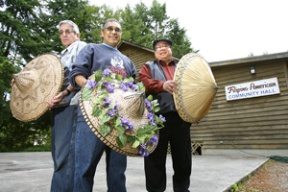The event honors farming, multicultural heritage today at the High School Rd. hall.
The word “bayanihan” encompasses a spirit – of helpfulness, community, cooperation, neighborliness – that permeates the culture of Filipino-Americans on Bainbridge.
And the annual Strawberry Festival, once largely an agricultural marker, has now come to serve as a symbol of all that Filipino-Americans have achieved and contributed to the island, despite cycles of generational change.
“It came about as a celebration of the farmers for the farmers,” Filipino-American Community president Rudy Rimando said. “For the culture and tradition of the physical act of farming, and to say ‘thank you.’”
Filipino-Americans’ history on Bainbridge is tightly intertwined with farming, and with a blending of cultures.
Forty-four young men immigrated to Bainbridge in the late 1920s, and in contrast to many Filipinos on the West coast who migrated with the work during the Depression, these men stayed put, finding not just work but also cultural compatibility on farms owned by Japanese Americans.
When those residents were interned during World War II, the Filipinos who worked their farms took over to ensure that crops survived and were harvested.
“The Filipino farmers really were helpers to the Japanese American farmers as a result of (their) unfortunate encampment,” Rimando said. “They trusted the Filipinos to take over their farms.”
With some running farms and others finding work in shipyards on the island and in Bremerton, young Filipinos found themselves in a position to put down their own roots. And as Native Canadian women began immigrating to Bainbridge to work the berry farms during war time, sparks flew and families grew.
“All of a sudden, the Filipinos and the Native Canadian ladies got together,” lifelong islander Doreen Almazan Rapada said. “I’m a product of that.”
Rapada’s Filipino father worked a Bainbridge berry farm and met Rapada’s mother, a member of British Columbia’s Squamish tribe, in 1942.
Even when he became a welder after the war, Rapada still leased a farm and grew berries. He’d do a night shift at the shipyard, then come home and farm. Rapada’s mother thought he was a workaholic. He found it theraputic.
“Everything ties in to the strawberries,” community association vice-president Ron Miguel said. “Because of the interchange, a lot of members of the Filipino American community are dual culture, and they celebrate both cultures.”
Today, Rimando and Miguel describe a community in transition.
The Strawberry Festival died off by the 1970s because the younger generation of Filipino Americans and Indipinos had little interest in the event. Rapada, who served as a princess in the first Strawberry Festival junior court in 1948, recalls how off-island jobs, kids’ extracurricular activities and the business of raising families eventually took the focus off the community as its own whole.
“Before, we were there every Saturday night, and we all sat down together. Things were great,” she said. “But then people got jobs not just on the berry farms but on the outside…and things just fell apart.
“The hall just kind of went into disrepair, and it didn’t seem like anyone was interested in keeping it up. Everybody had families, and all of us teenagers were gone.”
By the early 1990s, the Filipino-American hall had deteriorated so severely that the only thing preventing it from tipping over was an addition where the current kitchen was later built.
“There was one time when the fire department and the police department wanted to burn the building for practice,” Rimando said.
Community members rallied, and in 1993 the community began a project to restore the hall and secure its status on both the state and national Historic Registers.
The Strawberry Festival experienced a concurrent renaissance and became a gathering at which the Filipino-American and Indipino communities, and the island as a whole, celebrated their culture with traditional food, music and dancing along with the crowning of the festival’s young king and queen.
For many years, the queen, king and court were teens, but that these days the community is targeting youngsters closer to six or seven years old. He says they’re “more excited” about the Strawberry Festival court than older kids, who he sees heeding the call of technology, the media and other forms of diversion.
So while the hall is in fine form, and is still used for community events like the Strawberry Festival and the yearly Indipino Festival as well as for private events like wedding receptions, Rimando, Miguel and other community leaders are seeking ways to keep Filipino-American and Indipino youth interested.
Two plans in the works are a youth sports league and the establishment of a scholarship fund for graduating seniors to use toward their first year of college.
“It’s important we get them involved,” Miguel said, “however we do it.”
Meanwhile, back at Strawberry Hill, Rimando says the community is laying groundwork to run next year’s festival over two days. He plans to approach the Park District, the Downtown Association and the Chamber of Commerce to try to get the process rolling. He will also reach out to the Japanese American community.
“Let’s face it,” he said. “They were the experts in strawberry farming. If we can get them to celebrate with us, it would be more of an island event.”
In the spirit of history and good eating, Miguel says he still grows a crop of strawberries every year.
“That’s what started the whole thing,” Miguel said. “That’s what binded us together. I still binds us together today.”
************************************************************
Eat, drink, be berry
The Bainbridge Island Filipino-American Community hosts the annual Strawberry Festival from 11 a.m. to 3 p.m. June 23 at the Filipino-American Community Hall on High School Road.


